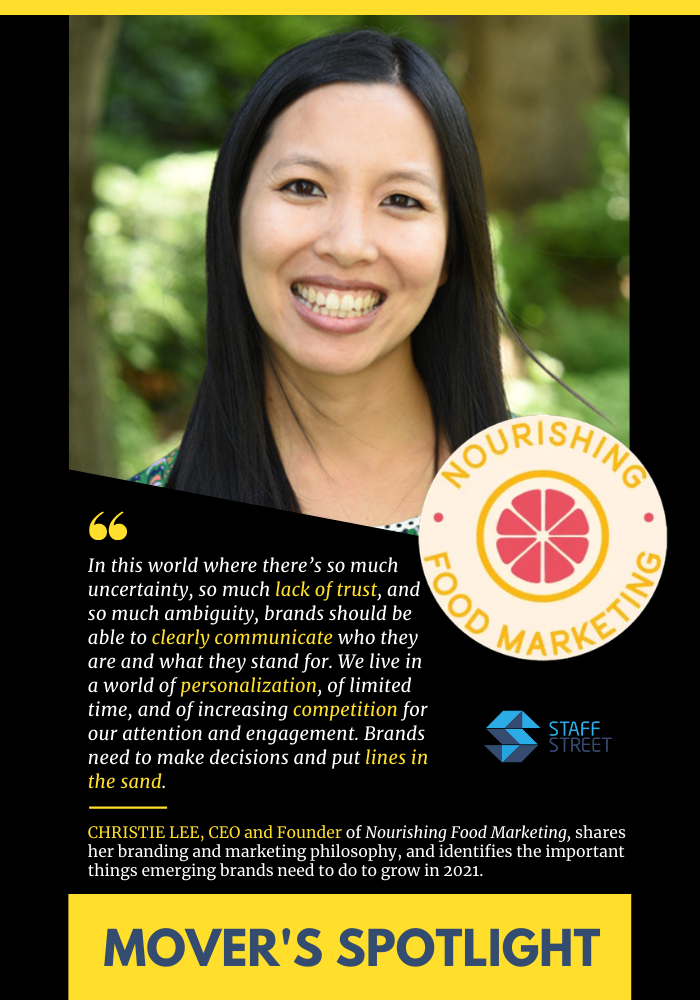
Talk a bit about how Nourishing Food Marketing started. How did it all come together?
Christie Lee: I started Nourishing Food Marketing after exiting the food brand I started, Tiny Hero. Most new and emerging brands can’t afford full-time marketing help because we’re typically expensive. It just doesn’t make sense to bring someone on full-time.
I started Nourishing Food Marketing to provide tools and coaching to new and emerging brands, so, they, too, may have access to strategic marketing leadership. That way, they’re able to fill an internal resource gap and they’re able to access strategic marketing help more resource-efficiently.
And since then, where are you now in terms of your professional journey?
Christie Lee: Over the last couple of years, I’ve been able to work with over two dozen brands. Some on a long-term basis and some for shorter periods. I help brands do a really deep dive into their brand DNA and product positioning. Then, I coach them on how to execute on their marketing strategy in all of their communications. This year, I’m focused on developing more tools and services so I can help brands, no matter their size or budget.
If you had to narrow down your company’s marketing principles for small and emerging businesses, what would be the top three rules to live by?
Christie Lee: My industry thesis is that small and emerging food and beverage brands are going to disrupt and change a broken food system. I want to provide them with the tools to make that happen. Small brands should be able use the same tools that Coca Cola and McDonald’s used in order to dominate the world.
My top rule is: be clear about your business objective. This comes from Big Food frameworks (I’ve worked at Clorox on American food brands like Hidden Valley Ranch and Kingsford Charcoal).
Secondly – be informed by data in making your business decisions. Don’t let perfect be the enemy of progress. But there are quick and scrappy ways that you can learn from your consumers (think IG story and newsletter surveys). It will not be perfect data. It will not be complete data, But it’s better than relying on our gut to make decisions.
Lastly, be clear about your metrics so you can compare tactics to each other, including inbound opportunities. Where should you spend your money and time? You can only answer this question if you can look at metrics across tactics. For example, how much does it cost to get a sample into a target consumer’s hands? And of course, track these metrics so you can see how you’re doing over time and against industry benchmarks.
I’ve taken the best practices and experiences I’ve had building (almost) billion-dollar brands to help build engaging brands that consumers love.
What kind of tools and frameworks do you work with that think small companies need to take note of?
Christie Lee: One of the tools that I have is my approach to developing your brand marketing strategy. I help brands map out three months of all the work streams that they should be thinking about with my framework.
First, set your business objectives. Everything starts from there. What do you want to accomplish in your business? Then, what are your marketing objectives in order to achieve those business objectives? Everything should ladder up.
After that, ask yourself, what tactics can you use in order to achieve those marketing objectives? Only then can we prioritize those tactics in order to achieve the marketing objectives that then meet their business objectives.
It’s a thought-through framework that most small brands don’t really have in place. A lot of founders will say, “I got this email for this radio show that I can do advertising on.” And I’m like, “Hold on, let’s not look at that opportunity individually.” We should say, instead, “Does this do a better job than something I’m currently spending my money on in order to achieve my objectives?”
You can learn more about this framework of thinking about what you’re doing in your marketing and why you’re doing it with the step-by-step Marketing Strategy guide I put together. Remember – it’s not enough that you’re doing marketing. It’s much more impactful for your business if your marketing is linked to business objectives.
With COVID, a lot of companies, big and small, have had to pivot and get creative. We’ve spoken with food and beverage companies who had planned to sell to gyms and offices at the beginning of the year. They had to change strategies in the past 7 months and switch to selling online. What do companies need to keep in mind when they’re making huge pivots in their marketing objectives?
Christie Lee: There are two things that I shared with companies last year who were contemplating serious changes to their business objective.
One, any change you make must be a long-lasting change.
You don’t start selling into brick-and-mortar retail for six months and make a profit. Everything takes investment. Everything takes time to be profitable. Likewise, you don’t start your e-commerce store or sell into Amazon for six months and say, “After the pandemic’s over, I’m not going to do this anymore.” Everything that you do should meet your business objectives.
Your pivots should be a reprioritization of your business objectives. They may have shifted in priority because of the pandemic. You may dedicate less or no resources to your food service channels or your plans for international expansion because of COVID-19. Instead, you’ll use those resources to tackle your top priority at the moment. Everything that you do in response to COVID-19 should be things that you’re trying to do in the long-term.
The other thing that I say is that with COVID-19, consumer behavior has changed. The world has changed. And that change is here to stay. So, as you think about your business objectives and your marketing objectives, ask yourself, how can you incorporate that into what you’re doing on a day-to-day basis.
For example, I don’t have a crystal ball, but consumers are purchasing more online. Are you set up to be omnichannel? Do you have content production in place to create an engaging experience with your DTC consumers?
In the same vein, are there strategies or pivots that you observed didn’t really work out for many companies?
Christie Lee: One strategy that I’ve seen lead to poor results is when brands deploy the same resources, the same people with the same skill set, to achieve much different business objectives. If you’re asking the employee to achieve something very different from what they were doing before, they may not have the skills they need. And, you may not have the time for them to retool and gain different skills. In this case, you’ll need to bring in outside expertise to help them get up the learning curve really quickly.
A lot of startups and companies are downsizing and outsourcing other facets of their job to keep up with the new normal. What do companies need to keep in mind and look out for from a marketing and branding standpoint when it comes to outsourcing their business processes to other places?
Christie Lee: I actually have an article about this: read my Three Tips on Working with Creatives.
As people are outsourcing or finding more efficient ways to get more done, it’s important to have the right tools in place to onboard people to your brand. Create a Brand Primer that is the single source of truth for your brand – who you are, what your brand DNA is, how to use your logo, what your main colors are, and so on. It is the reference guide for all of the partners that you work with. Remember that freelancers or consultants that are working on your brand are also working with multiple other brands. They need good tools to make sure that whatever they’re doing for your brand aligns with what you want.
The second thing is, as you think about outsourcing on projects, whatever they may be, you have to have the right framework and structures to make sure that everyone is on the same page. You have to decide what the messaging is, what your mandatories are, and what your specs are before you toss the project over the fence.
And it shouldn’t be in four different e-mails; keep it all in one document such as a Creative Brief. That way, everyone is on the same page and you have documentation of what you asked for. This upfront thinking will mean your projects happen more smoothly, on time and on budget.
Do you think that there’s a tasteful way for companies to integrate public discourse and political values such as social justice and equality into their brand marketing?
Christie Lee: I don’t think that brands should worry about being tasteful – they should be worried about being authentic.
Not everyone will agree with your brand’s values, and that’s OK. There are lots of choices in today’s world and being the perfect brand for your target consumer is better than being inoffensive. You’ll be stickier and those consumers will be less likely to switch brands the next time they’re in the grocery store.
In this world where there’s so much uncertainty, so much lack of trust, and so much ambiguity, brands should be able to clearly communicate who they are and what they stand for. All the things that you just mentioned – whether that’s social justice, Black Lives Matter, politics – all these topics that have been thought to get you in hot water, should be understood through the filter of your brand’s values. If they are important to you, talk about them!
A really good example of someone who’s doing this is Nike. They launched a beautiful marketing campaign in response to Black Lives Matter (For once, Don’t Do It) and I bet none of their consumers were surprised – after all, they’ve been working with Colin Kaepernick for years. Ben and Jerry’s is also doing amazing social justice work, and again, this has always been part of their brand.
That doesn’t mean that if you haven’t talked to social justice before, that you can’t decide that it’s a priority value for you in the future. However, you have to really choose this value and live it day-to-day. Do the work internally first.
As a brand, you only get five values. Five that you care about and communicate to your consumers. You can’t be a brand that has a hundred values, because then you stand for nothing. That’s just not the world we live in today. We live in a world of personalization, of limited time and increasing competition for our attention and engagement. Brands need to make decisions and put lines in the sand.
And that’s not to say that every brand can’t be a brand that cares about social justice. But every brand shouldn’t be. Maybe you care about children’s education or clean water. Whatever it is, you have to decide as a brand what you care about and you have to talk about that.
There are some brands whose values are distinctly tied to that of their founders. So, as their founders grow and change their values, what do they need to think about when they’re communicating those changes?
Christie Lee: Before you communicate anything, first you have to do the work. You have to identify how you’re going to work on the value internally. For example, if you have searched internally and decided that a top value for you is gender equality, you have to make sure your company itself meets those values before you talk about it to your consumers.
How are you going to raise the education level regarding gender equality with your employees? How will you hire team members or outside resources (agencies, freelancers, contractors) by those same values? Do the work internally, and then you can talk about the progress and change you’ve made. It’s not enough to say that you care about gender equality, you have to do the work first.
For Nourishing Food Marketing, what does 2021 look like? Where do you hope to see your clients in a year’s time? What kind of growth do you intend to bring into their lives?
Christie Lee: That’s such a personal question for each brand. For some, it’s launching a new product. For others, it’s getting into more stores. And for some, it’s building a new direct-to-consumer business. But what I wish for all my clients is that they are able to achieve the goals they set out in the beginning of the year. I hope that once they do the work, they are able to set themselves up for success in 2021. That requires figuring out the resources, identifying the work streams you need to do to get to that goal, and making it happen. And hopefully there’s no other curveball coming down the line in 2021.
Do you have any advice for a small food and beverage business that’s planning to launch during the pandemic? Something that they need to think about or focus on in this chaotic time?
Christie Lee: They need to understand their why and communicate it clearly across all of their marketing assets. It’s a lot of work to found a food company – why did you do it? Why do you wake up every day? Why are you doing what you’re doing? What inspired you? For inspiration, check out the video by Simon Sinek. Then, communicate this message consistently across every single one of your assets.

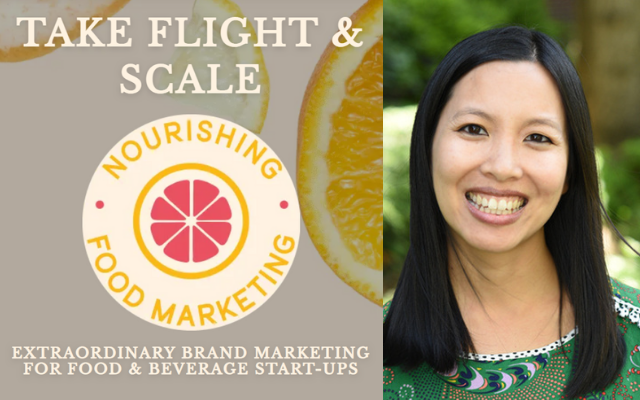



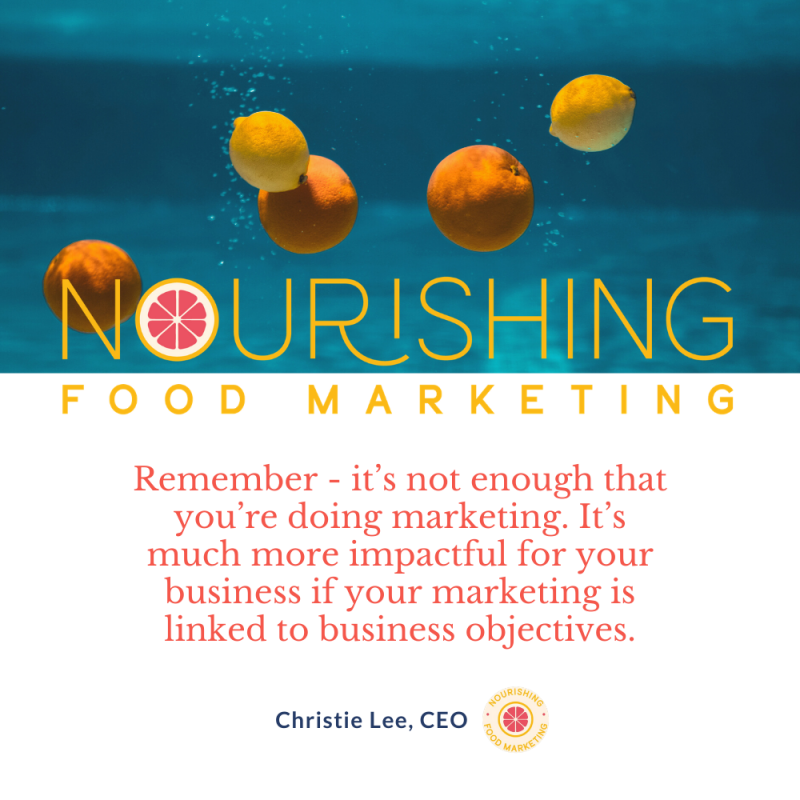


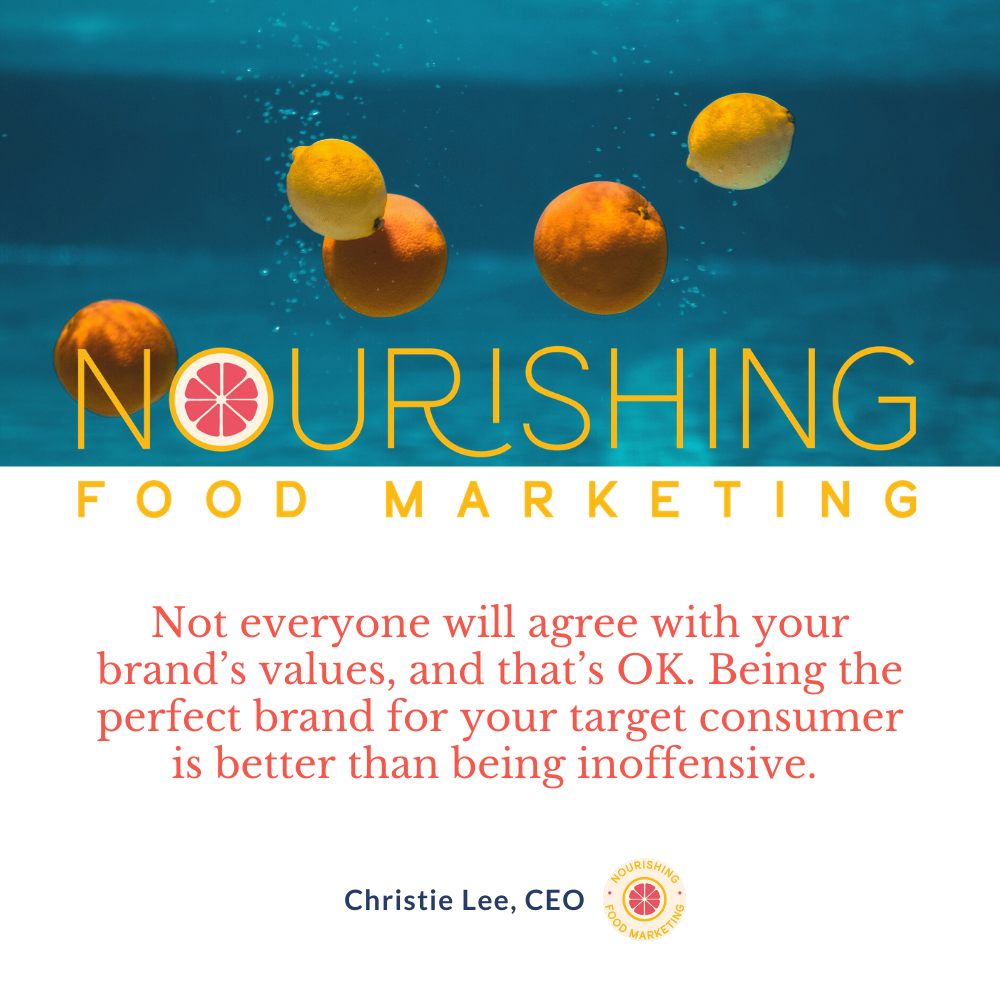

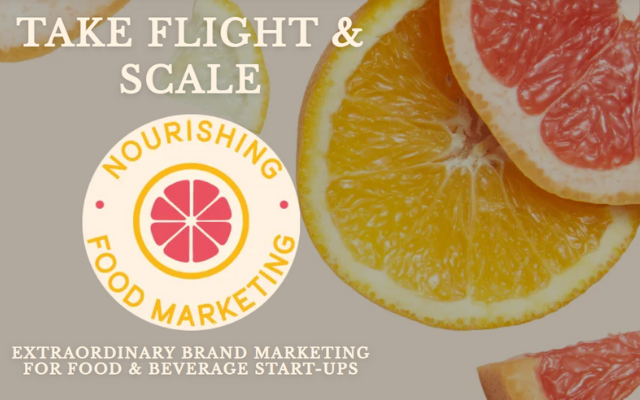


Pingback: One reason why you don't delegate work and five reasons why you should - Staff Street